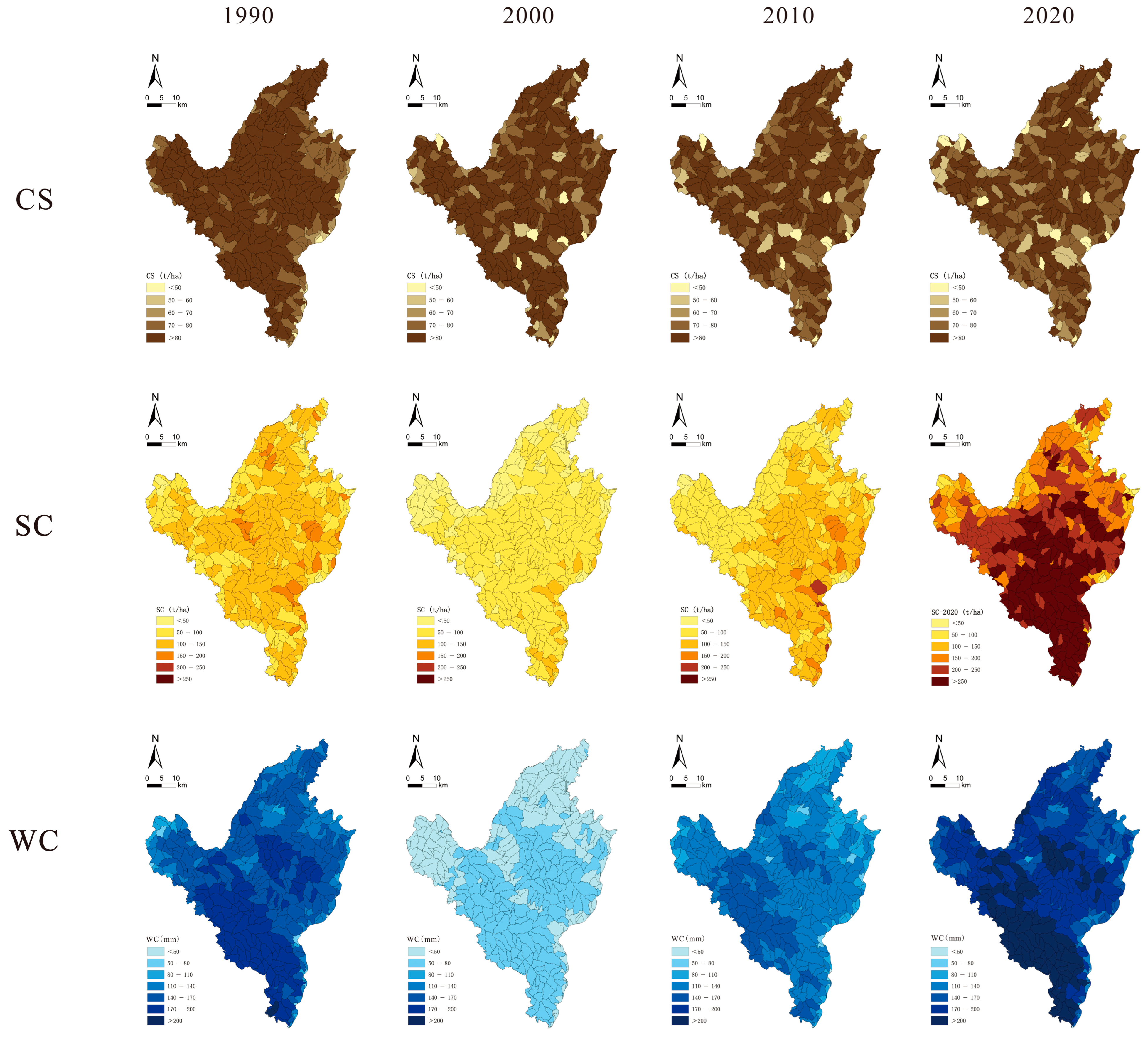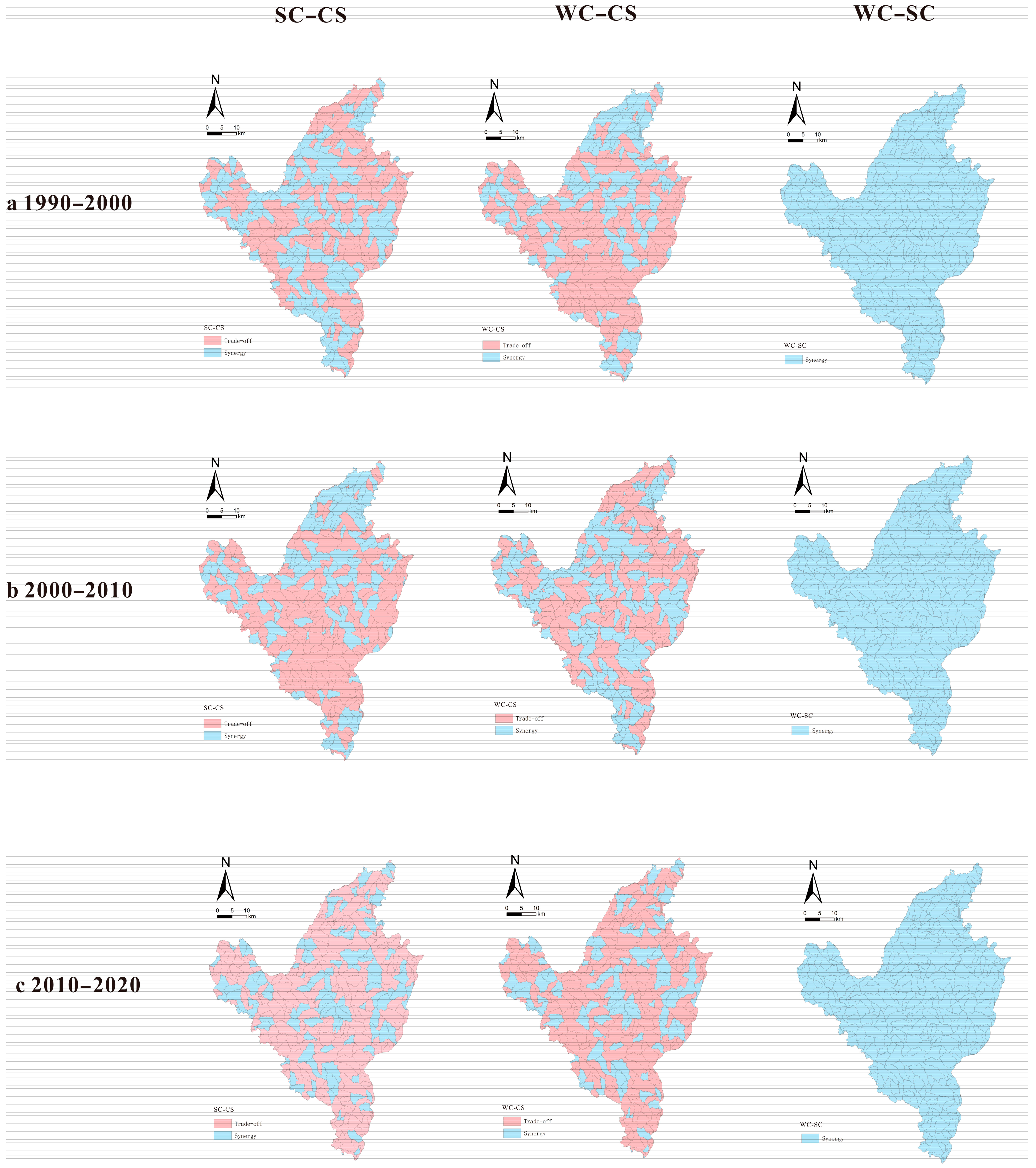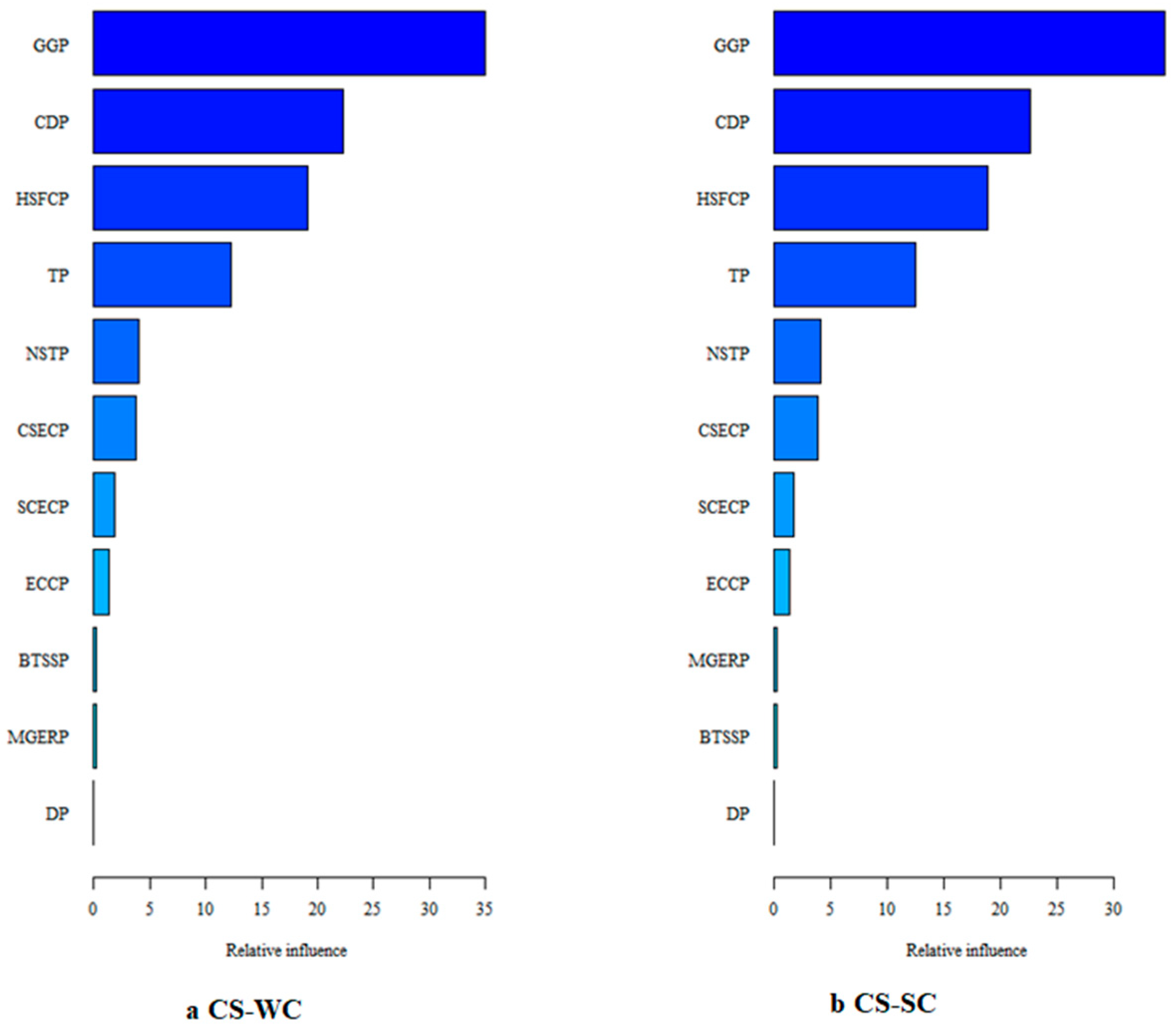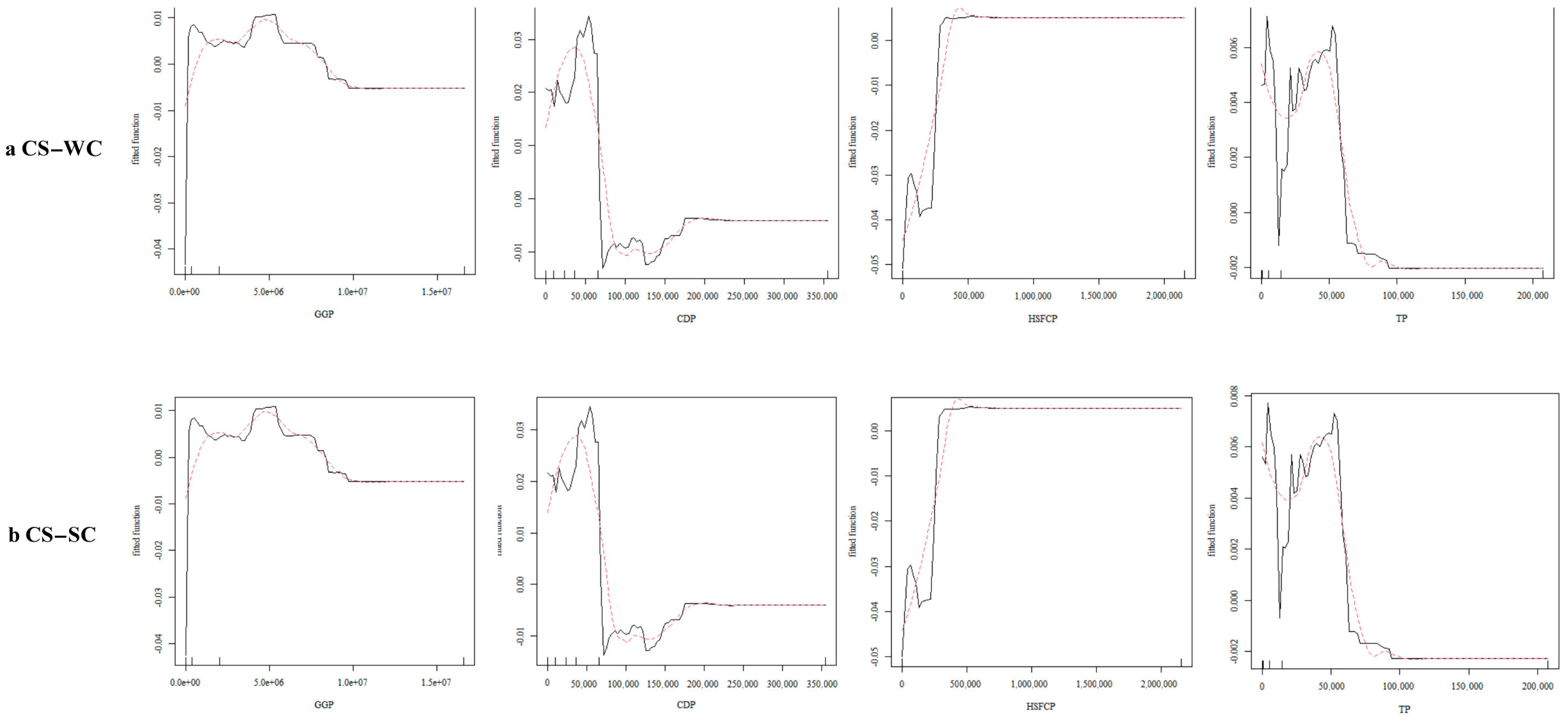How Do Ecological Restoration Projects Affect Trade-Offs and Synergies between Ecosystem Services?
Abstract
:1. Introduction
2. Materials and Methods
2.1. Study Area
2.2. Data Sources
2.3. Methodology
2.3.1. Evaluation of Ecosystem Services
2.3.2. Quantification of Trade-Offs and Synergies among Ecosystem Services
2.3.3. Analysis of the Correlation between ESRs and Ecological Restoration Project Factors
3. Results
3.1. Spatial and Temporal Distributions of Ecosystem Services
3.2. Spatial and Temporal Trends in the Trade-Offs and Synergies among Ecosystem Services
3.3. Impact of Ecological Engineering Factors on Synergies and Trade-Offs between ESs
3.3.1. The Contribution of Each Ecological Restoration Project Factor to ESRs
3.3.2. Nonlinear Relationship between ESRs and Significant Ecological Restoration Projects
4. Discussion
4.1. Ecological Restoration Project Impacts Trade-Offs and Synergies between the Ecosystem Services Pathways
4.1.1. The Path of GGP Affecting the Trade-Offs and Synergies between ESs
4.1.2. The Path of CDP Affecting the Trade-Offs and Synergies between ESs
4.1.3. The Path of HSFCP Affecting the Trade-Offs and Synergies between ESs
4.1.4. The Path of TP Affecting the Trade-Offs and Synergies between ESs
4.2. Limitations
5. Conclusions
Author Contributions
Funding
Data Availability Statement
Conflicts of Interest
References
- Costanza, R.; d’Arge, R.; De Groot, R.; Farber, S.; Grasso, M.; Hannon, B.; Limburg, K.; Naeem, S.; V. O’Neill, R.; Paruelo, J. The value of the world’s ecosystem services and natural capital. Nature 1997, 387, 253–260. [Google Scholar] [CrossRef]
- Cord, A.F.; Bartkowski, B.; Beckmann, M.; Dittrich, A.; Hermans-Neumann, K.; Kaim, A.; Lienhoop, N.; Locher-Krause, K.; Priess, J.; Schröter-Schlaack, C. Towards systematic analyses of ecosystem service trade-offs and synergies: Main concepts, methods and the road ahead. Ecosyst. Serv. 2017, 28, 264–272. [Google Scholar] [CrossRef]
- Bennett, E.M.; Peterson, G.D.; Gordon, L.J. Understanding relationships among multiple ecosystem services. Ecol. Lett. 2009, 12, 1394–1404. [Google Scholar] [CrossRef]
- Dai, E.; Wang, X.; Zhu, J.; Gao, J. Progress and trend outlook of ecosystem service trade-offs/synergies research. Adv. Earth Sci. 2015, 30, 1250. [Google Scholar]
- Feng, Z.; Jin, X.; Chen, T.; Wu, J. Understanding trade-offs and synergies of ecosystem services to support the decision-making in the Beijing–Tianjin–Hebei region. Land Use Policy 2021, 106, 105446. [Google Scholar] [CrossRef]
- Zhang, Z.; Liu, Y.; Wang, Y.; Wang, Y.; Liu, Y.; Zhang, Y. What factors affect the synergy and tradeoff between ecosystem services, and how, from a geospatial perspective? J. Clean. Prod. 2020, 257, 120454. [Google Scholar] [CrossRef]
- Andersson, E.; McPhearson, T.; Kremer, P.; Gomez-Baggethun, E.; Haase, D.; Tuvendal, M.; Wurster, D. Scale and context dependence of ecosystem service providing units. Ecosyst. Serv. 2015, 12, 157–164. [Google Scholar] [CrossRef]
- Dallimer, M.; Davies, Z.G.; Diaz-Porras, D.F.; Irvine, K.N.; Maltby, L.; Warren, P.H.; Armsworth, P.R.; Gaston, K.J. Historical influences on the current provision of multiple ecosystem services. Glob. Environ. Chang. 2015, 31, 307–317. [Google Scholar] [CrossRef]
- Tomscha, S.A.; Sutherland, I.J.; Renard, D.; Gergel, S.E.; Rhemtulla, J.M.; Bennett, E.M.; Daniels, L.D.; Eddy, I.M.S.; Clark, E.E. A guide to historical data sets for reconstructing ecosystem service change over time. BioScience 2016, 66, 747–762. [Google Scholar] [CrossRef]
- Renard, D.; Rhemtulla, J.M.; Bennett, E.M. Historical dynamics in ecosystem service bundles. Proc. Natl. Acad. Sci. USA 2015, 112, 13411–13416. [Google Scholar] [CrossRef]
- Mandle, L.; Tallis, H.; Sotomayor, L.; Vogl, A.L. Who loses? Tracking ecosystem service redistribution from road development and mitigation in the Peruvian Amazon. Front. Ecol. Environ. 2015, 13, 309–315. [Google Scholar] [CrossRef]
- Yang, L.; Feng, Q.; Chen, L. Ecosystem services of soil and water conservation engineering measures in the Loess Plateau. Resour. Sci. 2020, 42, 87–95. [Google Scholar]
- Wang, X.; Peng, J.; Luo, Y.; Qiu, S.; Dong, J.; Zhang, Z.; Vercruysse, K.; Grabowski, R.C.; Meersmans, J. Exploring social-ecological impacts on trade-offs and synergies among ecosystem services. Ecol. Econ. 2022, 197, 107438. [Google Scholar] [CrossRef]
- Zhang, J.; Wang, Y.; Sun, J.; Chen, J.; Zhang, J.; Dong Wang, D.; Huo, H.; Liang, E. Interactions between the Grain-for-Green Program and check dams increased vegetation carbon sequestration in the Yanhe basin, Loess Plateau. Land Degrad. Dev. 2023, 34, 2310–2321. [Google Scholar] [CrossRef]
- Pan, Q.; Wen, Z.; Wu, T.; Zheng, T.; Yang, Y.; Li, R.; Zheng, H. Trade-offs and synergies of forest ecosystem services from the perspective of plant functional traits: A systematic review. Ecosyst. Serv. 2022, 58, 101484. [Google Scholar] [CrossRef]
- Liu, J.; Li, S.; Ouyang, Z.; Chen, X. Ecological and socioeconomic effects of China’s policies for ecosystem services. Proc. Natl. Acad. Sci. USA 2008, 105, 9477–9482. [Google Scholar] [CrossRef] [PubMed]
- Wang, X.M.; Liu, X.C.; Long, Y.X.; Zhang, Y.; Liang, W.; Hong, M.; Yu, X. Spatial-temporal changes and influencing factors of ecosystem services in Shaoguan City based on improved InVEST. Res. Soil Water Conserv. 2020, 27, 381–388. [Google Scholar]
- Lyu, R.; Clarke, K.C.; Zhang, J.; Feng, J.; Jia, X.; Li, J. Spatial correlations among ecosystem services and their socio-ecological driving factors: A case study in the city belt along the Yellow River in Ningxia, China. Appl. Geogr. 2019, 108, 64–73. [Google Scholar] [CrossRef]
- Dou, H.; Li, X.; Li, S.; Dang, D.; Li, X.; Lyu, X.; Li, M.; Liu, S. Mapping ecosystem services bundles for analyzing spatial trade-offs in inner Mongolia, China. J. Clean. Prod. 2020, 256, 120444. [Google Scholar] [CrossRef]
- Gou, M.; Li, L.; Ouyang, S.; Wang, N.; La, L.; Liu, C.; Xiao, W. Identifying and analyzing ecosystem service bundles and their socioecological drivers in the Three Gorges Reservoir Area. J. Clean. Prod. 2021, 307, 127208. [Google Scholar] [CrossRef]
- Xu, S.; Liu, Y.; Wang, X.; Zhang, Z. Scale effect on spatial patterns of ecosystem services and associations among them in semi-arid area: A case study in Ningxia Hui Autonomous Region, China. Sci. Total Environ. 2017, 598, 297–306. [Google Scholar] [CrossRef] [PubMed]
- Karimi, J.D.; Corstanje, R.; Harris, J.A. Understanding the importance of landscape configuration on ecosystem service bundles at a high resolution in urban landscapes in the UK. Landsc. Ecol. 2021, 36, 2007–2024. [Google Scholar] [CrossRef]
- Qiu, J.; Turner, M.G. Spatial interactions among ecosystem services in an urbanizing agricultural watershed. Proc. Natl. Acad. Sci. USA 2013, 110, 12149–12154. [Google Scholar] [CrossRef] [PubMed]
- Feng, J.F.; Wang, H.L.; Zhu, L. Review on alternative stable states in ecosystems. Ecol. Environ. Sci. 2009, 18, 1553–1559. [Google Scholar]
- Fu, B.; Tian, H.; Tao, F.; Zhao, W.; Wang, S. Impacts of Global Change on Ecosystem Services. Basic Sci. China 2017, 22, 25–30. [Google Scholar]
- Tang, Z.; Zhou, Z.; Wang, D.; Luo, F.; Bai, J.; Fu, Y. Impact of vegetation restoration on ecosystem services in the Loess plateau, a case study in the Jinghe Watershed, China. Ecol. Indic. 2022, 142, 109183. [Google Scholar] [CrossRef]
- Yu, Z.Y.; Deng, X.Z.; Cheshmehzangi, A. The grain for green program enhanced synergies between ecosystem regulating services in Loess Plateau, China. Remote Sens. 2022, 14, 5940. [Google Scholar] [CrossRef]
- Fu, B.J. Ecological and environmental effects of land-use changes in the Loess Plateau of China. Chin. Sci. Bull. 2022, 67, 3768–3779. (In Chinese) [Google Scholar] [CrossRef]
- Li, R.N.; Zheng, H.; O’Connor, P.; Xu, H.; Li, Y.; Lu, F.; Robinson, B.E.; Ouyang, Z.; Hai, Y.; Daily, G.C. Time and space catch up with restoration programs that ignore ecosystem service trade-offs. Sci. Adv. 2021, 7, eabf8650. [Google Scholar] [CrossRef] [PubMed]
- Sharp, R.; Chaplin-Kramer, R.; Wood, S.; Guerry, A.; Tallis, H.; Ricketts, T.; Nelson, E.; Ennaanay, D.; Wolny, S.; Olwero, N.; et al. InVEST 3.5. 0 User’s Guide; Stanford University: Stanford, CA, USA, 2018. [Google Scholar]
- Renard, K.G. Predicting Soil Erosion by Water: A Guide to Conservation Planning with the Revised Universal Soil Loss Equation (RUSLE); US Department of Agriculture, Agricultural Research Service: Washington, DC, USA, 1997. [Google Scholar]
- Huang, L.; Zhu, P.; Cao, W. The impacts of the Grain for Green Project on the trade-off and synergy relationships among multiple ecosystem services in China. Acta Ecol. Sin. 2021, 41, 1178–1188. [Google Scholar]
- Feng, X.; Fu, B.; Piao, S.; Wang, S.; Ciais, P.; Zeng, Z.; Lü, Y.; Zeng, Y.; Li, Y.; Jiang, X.; et al. Revegetation in China’s Loess Plateau is approaching sustainable water resource limits. Nat. Clim. Chang. 2016, 6, 1019–1022. [Google Scholar] [CrossRef]
- Li, X.R.; Jin, Z.; Zhang, X.B.; Zhou, W.J. Analysis of ecosystem management of the Loess Plateau during the past 60 years and suggestions for the future development. J. Earth Environ. 2015, 6, 248–254. [Google Scholar]
- Smith, T.; Boers, N. Global vegetation resilience linked to water availability and variability. Nat. Commun. 2023, 14, 498. [Google Scholar] [CrossRef] [PubMed]
- Li, S.; Liu, M. The Development Process, Current Situation and Prospects of the Conversion of Farmland to Forests and Grasses Project in China. J. Resour. Ecol. 2022, 13, 120–128. [Google Scholar]
- Zhang, P.; Shao, G.; Zhao, G.; Master, D.C.; Parker, G.R.; Dunning, J.B.; Li, Q. China’s forest policy for the 21st century. Science 2000, 288, 2135–2136. [Google Scholar] [CrossRef] [PubMed]
- Lu, F.; Hu, H.; Sun, W.; Yu, G. Effects of national ecological restoration projects on carbon sequestration in China from 2001 to 2010. Proc. Natl. Acad. Sci. USA 2018, 115, 4039–4044. [Google Scholar] [CrossRef]
- Liu, B.J.; Lu, F.; Wang, X.K.; Liu, W.W. Greenhouse gas emissions, carbon leakage and net carbon sequestration from afforestation and forest management: A review. Ying Yong Sheng Tai Xue Bao J. Appl. Ecol. 2017, 28, 673–688. [Google Scholar]
- Zhang, K.; Dang, H.; Tan, S.; Cheng, X.; Zhang, Q. Change in soil organic carbon following the ‘Grain-for-Green’ program in China. Land Degrad. Dev. 2010, 21, 13–23. [Google Scholar] [CrossRef]
- Zhang, Y.; Li, P.; Liu, X.; Xiao, L.; Shi, P.; Zhao, B. Effects of farmland conversion on the stoichiometry of carbon, nitrogen, and phosphorus in soil aggregates on the Loess Plateau of China. Geoderma 2019, 351, 188–196. [Google Scholar] [CrossRef]
- Li, Y.; Li, Y.; Zhang, Q.; Xu, G.; Liang, G.; Kim, D.; Carmona, C.R.; Yang, M.; Xue, J.; Xiang, Y.; et al. Enhancing soil carbon and nitrogen through grassland conversion from degraded croplands in China: Assessing magnitudes and identifying key drivers of phosphorus reduction. Soil Tillage Res. 2024, 236, 105943. [Google Scholar] [CrossRef]
- Yang, L.; Wei, W.; Chen, L.; Chen, W.; Wang, J. Response of temporal variation of soil moisture to vegetation restoration in semi-arid Loess Plateau, China. Catena 2014, 115, 123–133. [Google Scholar] [CrossRef]
- Shi, P.; Li, Z.; Li, P.; Zhang, Y.; Li, B. Trade-offs among ecosystem services after vegetation restoration in China’s Loess Plateau. Nat. Resour. Res. 2021, 30, 2703–2713. [Google Scholar] [CrossRef]
- Xu, X.Z.; Zhang, H.W.; Zhang, O.Y. Development of check-dam systems in gullies on the Loess Plateau, China. Environ. Sci. Policy 2004, 7, 79–86. [Google Scholar]
- Liang, X.; Chen, Q. Large-scale construction of silt dams will not cause the Yellow River to stop flowing. China Soil Water Conserv. 2003, 11, 26–27. [Google Scholar]
- Gabet, E.J.; Sternberg, P. The effects of vegetative ash on infiltration capacity, sediment transport, and the generation of progressively bulked debris flows. Geomorphology 2008, 101, 666–673. [Google Scholar] [CrossRef]
- Ran, D.; Zhao, L.; Wang, H.; Liu, B.; Bai, C.G.; Ma, Y. Analysis of flood and sand reduction by terracing in the middle reaches of the Yellow River. People’s Yellow River 2005, 27, 51–53. [Google Scholar]
- Lesschen, J.P.; Cammeraat, L.H.; Nieman, T. Erosion and terrace failure due to agricultural land abandonment in a semi-arid environment. Earth Surface Process. Landf. J. Br. Geomorphol. Res. Group 2008, 33, 1574–1584. [Google Scholar] [CrossRef]







| ESs | Method | Calculation Process |
|---|---|---|
| Water conservation (WC) | The research utilized the water production component of the InVEST model to compute the water yield, which was calculated according to the discrepancy between annual evapotranspiration and actual precipitation [30]. Then, the values were corrected. | The following is the WY calculation formula: WY: water yield per year; AET: yearly actual evapotranspiration; P: yearly precipitation; WC: Water conservation per year; Velocity: flow rate coefficient; TI: topographic index; Ksat: Saturated soil hydraulic conductivity. |
| Soil conservation (SC) | The study computed both the present and potential soil erosion using the Sediment Delivery Ratio module in the InVEST model based on RUSLE to calculate SC [31]. | The following is the SC calculation formula: SC: the soil conservation per unit area; PKLS: the quantity of possible soil erosion per unit area; USLE: the actual quantity of soil erosion per unit area; R: the erosivity factor caused by rainfall; K: the issue of soil erodibility; LS: the factor of the slope length; C: the management parameters and crop/vegetation cover; P: the factor of erosion control practices. |
| Carbon storage (CS) | The carbon storage was estimated by combining the carbon pools of aboveground biomass, belowground biomass, soil organic matter, and dead organic matter using the carbon module of the InVEST model in this work [30]. | The following is the CS calculation formula: CS: the entire amount of stored carbon; Cabove: the carbon density of biomass found aboveground; Cbelow: the carbon density of biomass found belowground; Csoil: the carbon density of organic matter in the soil; Cdead: the storage of carbon in decomposing organic materials. |
Disclaimer/Publisher’s Note: The statements, opinions and data contained in all publications are solely those of the individual author(s) and contributor(s) and not of MDPI and/or the editor(s). MDPI and/or the editor(s) disclaim responsibility for any injury to people or property resulting from any ideas, methods, instructions or products referred to in the content. |
© 2024 by the authors. Licensee MDPI, Basel, Switzerland. This article is an open access article distributed under the terms and conditions of the Creative Commons Attribution (CC BY) license (https://creativecommons.org/licenses/by/4.0/).
Share and Cite
Ji, Y.; Xie, M.; Liu, Y.; Zhu, R.; Tang, Z.; Hu, R. How Do Ecological Restoration Projects Affect Trade-Offs and Synergies between Ecosystem Services? Land 2024, 13, 384. https://doi.org/10.3390/land13030384
Ji Y, Xie M, Liu Y, Zhu R, Tang Z, Hu R. How Do Ecological Restoration Projects Affect Trade-Offs and Synergies between Ecosystem Services? Land. 2024; 13(3):384. https://doi.org/10.3390/land13030384
Chicago/Turabian StyleJi, Yuhui, Miaomiao Xie, Yunxuan Liu, Renfen Zhu, Zhuoyun Tang, and Rongwei Hu. 2024. "How Do Ecological Restoration Projects Affect Trade-Offs and Synergies between Ecosystem Services?" Land 13, no. 3: 384. https://doi.org/10.3390/land13030384
APA StyleJi, Y., Xie, M., Liu, Y., Zhu, R., Tang, Z., & Hu, R. (2024). How Do Ecological Restoration Projects Affect Trade-Offs and Synergies between Ecosystem Services? Land, 13(3), 384. https://doi.org/10.3390/land13030384





